For the past few months I have been doing one on one time with Ben. This is a time where we do an activity together. The activity is chosen by me, and I also decide how long it lasts. I am doing this for a couple of reasons. One is that it gives Ben some special time just with me completely focused on him. Ali and Sammy still need a lot of my attention during the day, so this gives Ben some much needed time with just me. The second reason is that it lets me focus on activities that promote learning for Ben. We review letters, numbers, colors, shapes, etc. All the things little kids are working on. We also work on important skills like sitting still and staying focused.
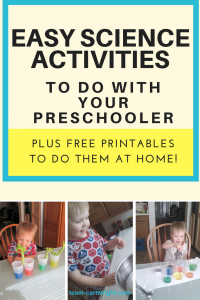
As we got used to doing these activities I have expanded them a bit. Every Wednesday we do an art project. And every Thursday I have started introducing some sort of science project. Doing science with a preschooler can sound intimidating. I know a lot of people have an innate fear/dislike of the subject. Plus it sounds like something that would be a lot of work and probably make a big old mess. Well, I don’t like these activities to take too long, nor do I want them to be a whole to do. I for sure don’t want them to make a big mess. So I am finding ways to introduce science that works for us.
My goals are pretty simple. I want to introduce some basic science principles with items that I have around the house. I don’t want to make a mess, and I want us to have fun while we do it. Basically I want to encourage Ben to think about the world around him, be encouraged to ask questions, and to want to learn new things.
Marshmallow Experiments
We’ve done three activities that went pretty well so far. I read about some marshmallow tests we could try. Ben loves marshmallows (as do I), so an eating portion would make anything fun. And we had some in the cabinet. Done. It went, well, okay. The first thing we tried was microwaving some big marshmallows as the site suggests. The site suggested microwaving them for 60 seconds. I only let them go about 20 seconds. Position a chair in front of the microwave and let your child watch. They do grow quickly! I don’t know what would have happened if we let it go the full time, but I knew for sure I didn’t want to have to clean out the microwave. So I stopped it there.
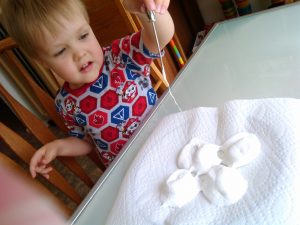
At this point the marshmallows were of course too hot to touch, but we were able to watch them deflate a bit. Ours were too hot to see if they were hollow inside after puffing up, and basically melted and wilted down. Not quite what I hoped would happen, but it still gave us plenty to talk about. What happened when the marshmallows were in the microwave? What does it melting mean? How does it compare to freezing? These might seem like pretty basic questions, and that is because they are. These are things that a three year old might not have thought about before. But he can see things that are frozen and things that melt in the world. We are working on the vocabulary behind what we observe and are starting to predict what we think will happen.
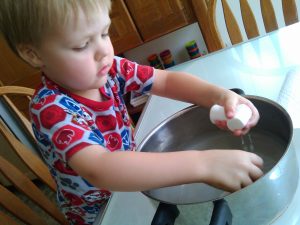 After we microwaved the marshmallows we pulled out a pot of water. I asked Ben if he thought they would sink or float? Again, this seems like a no brainer to you and me. But small kids are still learning about the consistencies in the world. (This is part of why babies love to drop things. Is it going to fall to the floor every time? What will happen if I drop this other object? They don’t realize it, but they are testing the natural rules of the physical world.) He predicted they would float, so we tried it. Ben was so excited to see he was right! We tried pushing down on the marshmallows to get them to sink, but they kept popping back up. We talked about sinking and floating. I asked him about other objects, and if he thought they would sink or float.
After we microwaved the marshmallows we pulled out a pot of water. I asked Ben if he thought they would sink or float? Again, this seems like a no brainer to you and me. But small kids are still learning about the consistencies in the world. (This is part of why babies love to drop things. Is it going to fall to the floor every time? What will happen if I drop this other object? They don’t realize it, but they are testing the natural rules of the physical world.) He predicted they would float, so we tried it. Ben was so excited to see he was right! We tried pushing down on the marshmallows to get them to sink, but they kept popping back up. We talked about sinking and floating. I asked him about other objects, and if he thought they would sink or float.
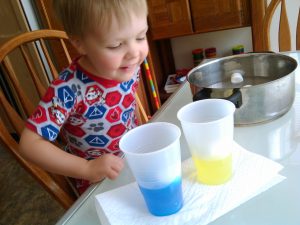 Finally we took some colored water and put a marshmallow in it. We let it soak for a few minutes, then I asked him if he thought the color would soak in or not. He wasn’t sure. I kind of thought it would. We cut it open and nope! It stayed white inside. Honestly at this point Ben was pretty primed to eat a marshmallow and play with the water some more, so the conversation was pretty short. Basically some items keep water out, like his plastic boats. Others let the water in, like a sponge.
Finally we took some colored water and put a marshmallow in it. We let it soak for a few minutes, then I asked him if he thought the color would soak in or not. He wasn’t sure. I kind of thought it would. We cut it open and nope! It stayed white inside. Honestly at this point Ben was pretty primed to eat a marshmallow and play with the water some more, so the conversation was pretty short. Basically some items keep water out, like his plastic boats. Others let the water in, like a sponge.
This was a great set of experiments to point out that things might not work the way we expect them to, or want them to for that matter. And that is okay! We were still able to ask questions and talk about what we saw. I am teaching Ben to observe, ask, and test.
Color Mixing
After seeing how much Ben loved the food coloring we used in the marshmallow experiment I decided to do some color mixing with him. This one just needs some cups and food coloring. I used clear plastic cups to make it easier to see the colors and to aid in clean up. (I managed to permanently dye some tea cups one year dying Easter Eggs, so I’m a little hesitant to use food coloring in non-disposable cups now.) We also used measuring spoons just as small spoons to add colors, and a toothpick for the actual mixing.
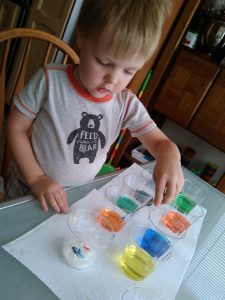 I started with the primary colors- red, blue, and yellow. We mixed red and blue to get purple, then the red and yellow to get orange, and finally the blue and yellow to get green. Ben adored this. Think about it from a preschooler’s perspective- you mix two different colored solutions together to get an entirely new color? It’s like magic! I tried to talk about primary versus secondary colors. That might be a bit much for the age, but as I’ve said a lot of this is just about exposure.
I started with the primary colors- red, blue, and yellow. We mixed red and blue to get purple, then the red and yellow to get orange, and finally the blue and yellow to get green. Ben adored this. Think about it from a preschooler’s perspective- you mix two different colored solutions together to get an entirely new color? It’s like magic! I tried to talk about primary versus secondary colors. That might be a bit much for the age, but as I’ve said a lot of this is just about exposure.
We tried mixing the colors in milk instead of water. It did let you see the mixing happen a bit better, but you had to watch closely. So I put a bit of yogurt in a cup and added the food coloring directly to that. I let Ben mix it up slowly. With the thicker yogurt you could actually see the mixing happen, with the red and blue still visible while the purple appeared. Very cool. After that I just let Ben play. He told me what he wanted to mix and we saw what we could make!
There are a couple of things I would change about what we did. It would be awesome if we had little droppers so Ben could control the mixing a little better. The measuring spoons work, but I get a little nervous about staining with food coloring, so I felt the need to hover a lot. I would also get some popsicle sticks to mix in the yogurt. Ben loves the little penguin toothpicks we have, and he had a lot of fun using them. I just think a stick would make it easier to mix and see the color transitions.
Overall this one was a big hit. We talked about colors, transparency (the yogurt compared to the water), and light versus dark. I plan to pull this one out again, just because Ben enjoyed it so much.
Celery Experiments
I talked about this one on Facebook already, but I want to have a blog record of it. The very first experiment we did was the celery experiment. I remember doing this one in elementary school. All it takes is celery, food coloring, and cups.
I cut some celery stalks (keep the leaves on) and put them in colored water. That’s it. No really, that was really the gist of it. What happens is the celery drinks up the water and you can see it travel up the stalk and into the leaves. Red and blue coloring work best for this. You can take it up a notch by splitting a stalk and putting half in the red and half in the blue. The top part will turn purple!
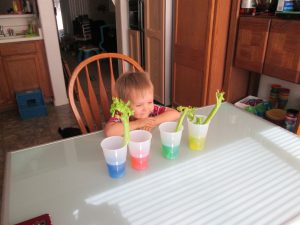
It does take some time to see the colors, but Ben loved checking on his plants throughout the day. With this one we talked about what plants need to grow. One thing they need is water, and they drink that up through channels inside them.
All these activities can be as involved as you want them to be. Ben has been pretty interested in them, so we kept at it for about 30 minutes. There is minimal set up and clean up, and most of the items needed are things you can have in your house anyway. We spend a lot of time observing and talking. The biggest thing it to ask your child what they think is going on and then listen. They don’t have to get things ‘right’ to be learning. The point is just to get them thinking.
Finally, I want to remind you to try not to over think what you need to explain. If your child is really in to a topic by all means help them find out more. You do not have to be an expert on anything though. Trust me, you have enough working knowledge of the world around you to teach your kids the basics. Anything else you can look up together. Learning how to seek out answers can be just as important as knowing them. And have fun!
Want some cheat sheets to print out to try any of these with your kids? I’ve got you covered.
Marshmallow experiments Color experiments Celery experiments
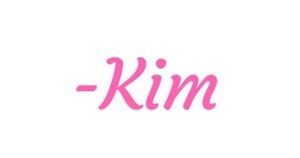
Still unsure if you should be doing science activities with your kids? You can read why I think we need to not fear science, and how to go about doing it. (Okay, yes. It’s kind of a rant. But I stand by my message. Science is everywhere, let’s help our kids embrace it!)
![]()

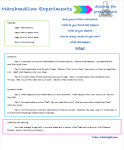
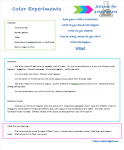
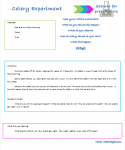
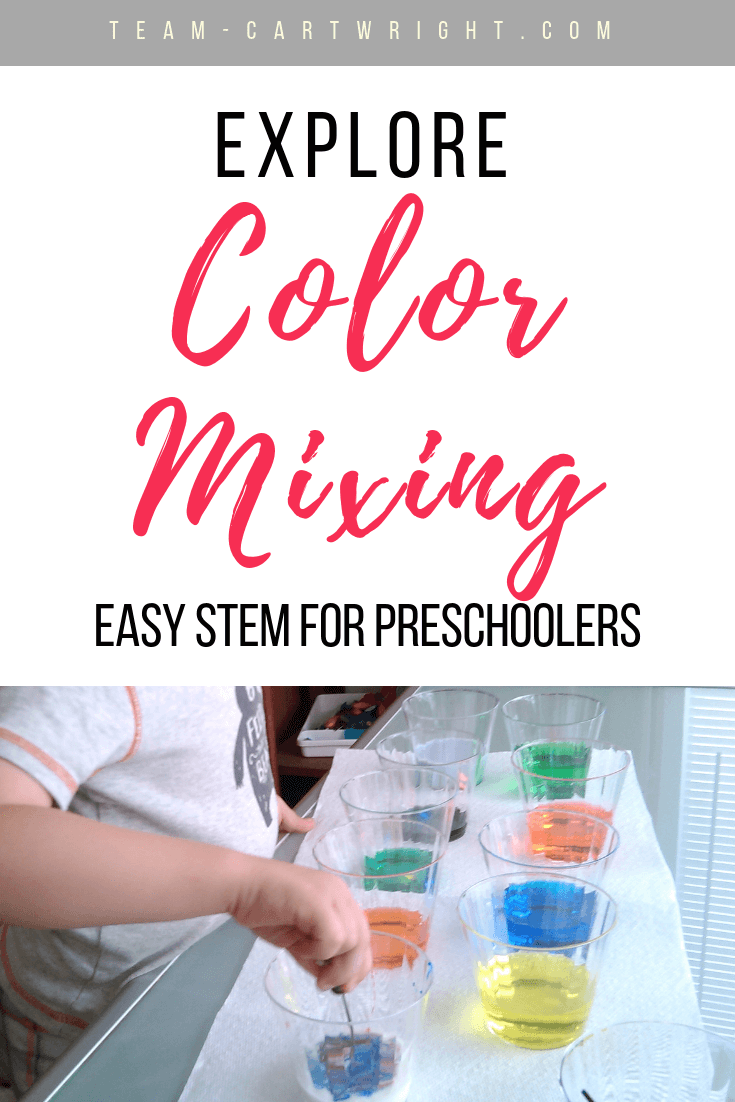


Jenny
Sunday 11th of June 2017
I homeschool so I have done a lot of these activities. I especially like the color mixing projects.
Hena Jose
Saturday 10th of June 2017
I too believe that science need to be taught in an engaging. These simple experiments are too good for small kids.
Jasmine Hewitt
Friday 9th of June 2017
the marshmallow experiment looks really neat!
Bailey
Friday 9th of June 2017
This marshmallow experiment is really neat! I think this will e right up the alley of my young toddler in a couple months - especially when the sun disappears and the snow falls and we are trapped inside again! Thanks for the suggestion
Alexandra
Friday 9th of June 2017
I loved the basics of the marshmallow "experiement" (I wouldn't let it engulf my microwave either. That stuffy is STICKY.). Comparison, prediction, and vocabulary building are great concepts to discuss just from nuking a mallow!